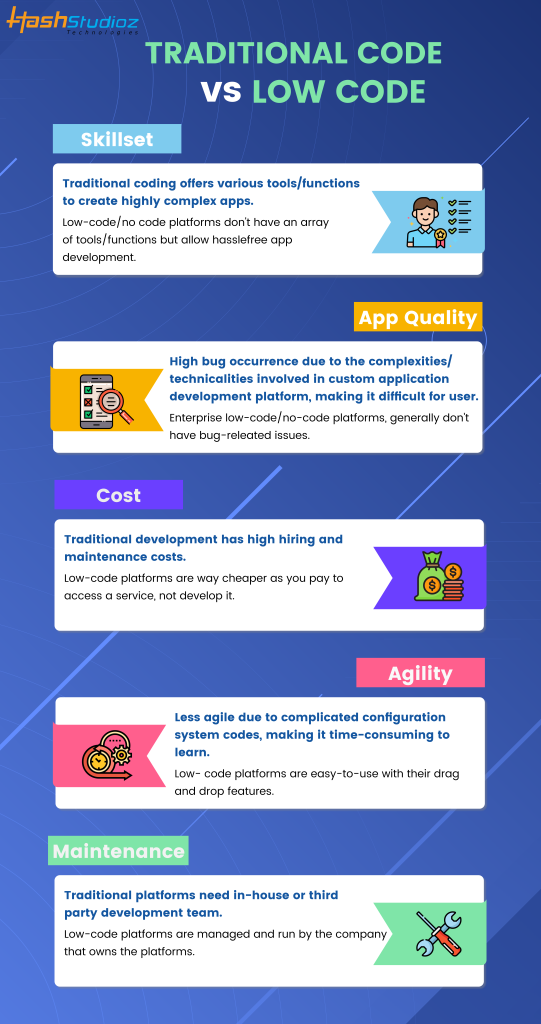Best Info For Choosing application development with Low-code platforms
Best Info For Choosing application development with Low-code platforms
Blog Article
Benefits Of Low-Code Application Development For Non-Developers
Due to a number of factors, low-code application development is easier to non-developers. These are sometimes referred to as "citizens developers."
Drag-and-Drop Builders: Low-code platforms come with drag-and-drop interfaces that allow non-developers to develop applications without needing to write code. This lets development be more accessible to those with no technical background.
WYSIWYG Editors: "What You See Is What You Get" editors allow users to build interfaces and workflows an approach that is similar to the final product, making it much easier to use and understand.
Simple Logic and Workflow
Visual Workflow modeling: Users create business flows and application logic using visual flowcharts. The models are easier to use than traditional method of programming.
Pre-built Components for Logic: Low-code platform often includes already-built logic (e.g. loops and conditional statements) that can easily be configured, reducing a requirement for complicated programming.
Reusable Components & Templates
Library of Templates Pre-built: Many platforms that offer low-code have templates that are suitable for most applications. This lets developers get started quickly and easily and non-developers to modify the templates however they see fit.
Reusable widgets and modules: The creation of a website is simplified through the use of reusable components and modules. This means that there is less need for deep technical knowledge.
Guided Development and Tutorials
Step-by step guides: Platforms offer tutorials, on-screen tips, and development guides to help non-developers build applications.
Interactive Tutorials Interactive, hands-on tutorials allow users to learn through doing, increasing their understanding and confidence in using the platform.
Integration with Existing Tools
seamless integration: Low-code platforms are designed to be integrated seamlessly with existing business tools, systems, and software (e.g., ERP, CRM, ERP). This allows non-programmers with no prior experience in programming to design applications that work with their existing workflows.
APIs Connectors, APIs: These tools simplify integration by allowing non-developers (or even end users) to link their applications with external services.
Collaboration Features:
Team Collaboration - Features like real-time team collaboration and shared workspaces allow non-developers to work effectively alongside professionals, developers, analysts, and the other stakeholders.
Role-based Access Control: Developers can be assigned specific roles that have appropriate access levels, which ensures they can contribute to the development process without compromising security or functionality.
Automated Testing and Debugging:
Built-in Testing Tools: Platforms that are low-code typically come with built-in testing and debugging tools that can automate these processes, making it easier for non-developers and users to ensure that their applications work correctly.
Error Highlighting When problems occur, the platform highlights these and suggests possible fixes. It assists non-developers with troubleshooting.
Low-code development is easier for non-developers to access because it democratizes the development process. Through providing visual-friendly tools and experiences, low-code platforms allow business owners to actively take part in and manage applications. See the top website about Low-code Platform for application development for blog info including push notifications android, jdbc server, app platforms, low code development platforms, rapid app development, develop web app, push alerts, mobile app development platforms, application development platforms, paas service and more.
Benefits Of Developing Applications Using Low-Code In Terms Of Cost-Efficiency
Low-code development offers many advantages in terms of cost-effectiveness. This makes it an ideal choice for businesses that want to optimize their development budgets, while still delivering high quality applications. The main advantages:
A lower code platform reduces the need for long manual code. This saves time and effort on the part of developers in developing their applications. It also means lower labor cost.
A smaller number of developer resources: As low-code development is faster and simpler, less specialized developers are required. This will dramatically reduce hiring and staffing expenses.
Faster Time to Market
Accelerated Development Cycle The visual development tools and pre-built components offered by low-code platforms enable rapid application development, which allows businesses to bring products to market quicker. This can translate into more revenue and sales and improved position in the marketplace.
Rapid Prototyping: Businesses are able to quickly develop prototypes and then test them, reducing the time required in the development stage and allows for quicker iterations that are based on feedback from the users.
Low Maintenance Costs
The modular design and standard components of apps developed using low-code platforms makes them simpler to maintain. This can reduce the expense of ongoing maintenance and support.
Automated Patches and Updates Low-code platforms are able to handle patching and updating applications automatically. This means that the application is protected and always up to date with no manual intervention.
Efficient Resource Utilization:
Contributions from non-developers: Low code platforms allow non-developers, like business users, to contribute to the process of development. This democratization enables businesses to take advantage of the expertise of a broad variety of employees.
Optimized Use of IT Resources: IT departments are able to focus on more strategic initiatives rather than being bogged down with mundane development tasks, improving overall productivity and efficiency.
Scalable Pricing Models
Subscription Pricing: A lot of platforms that use low-code provide different pricing options based on subscriptions that are scaled according to usage. This allows businesses to make sure that their budget is in line with their needs and grow.
Pay-Assosiated Option: A few platforms provide pay-assosiated choices. They ensure that businesses are only liable for the services they use which is advantageous to small and new businesses with limited funds.
Reduced Third-Party Software costs:
Low-code platforms typically come with integrated functions that eliminate the need to purchase additional software or tools. This could save you money on subscriptions and software licensing costs.
Pre-Built Intergrations: The availability and pre-built integrations with popular services and system minimizes the requirement for custom development, and helps save time and money.
Higher ROI
A faster return on investment: Combining rapid development with lower costs and a faster speed to market, businesses are able to get a higher return on investments (ROI).
Increased Agility: Businesses are able to quickly adapt to changes in the market and demands of their customers to ensure they remain relevant and can capitalize on emerging opportunities when they occur.
Costs of training are lower:
User-friendly interfaces: Low-code systems provide user-friendly and easy interfaces that reduce the time required to learn. They also eliminate the need for lengthy training programs.
Accessible Resources: Many low-code platforms offer extensive training materials, tutorials, as well as community support, cutting the need for formal training and the associated expenses.
Streamlined Collaboration:
Collaboration Tools: Integrated collaboration tools enhance communication and coordination between teams, resulting in improved processes for development and reduced costs.
Unified Development Environment (UDE): A single, unifying development environment streamlines processes and cuts cost and complexity that comes with managing different tools and platforms.
Low-code development is cost-effective because it reduces development and maintenance expenses. It also reduces time to market and optimizes resource usage. Pricing models are flexible. These elements provide huge economic rewards for businesses. Low-code development is an excellent option for companies that wish to make the most of their budgets, but also develop robust, scalable and high-quality software. Check out the best Legacy application modernization with Low-code tips for site tips including no code platforms, application modernization, rapid applications, software for app development, rapid action development, multiplatform mobile app development, low code platforms, push notifications android, lowcode no code, rad development and more.
Advantages Of Low-Code Application Development In Terms Of Vendor Support And Community
Low-code development platforms have significant advantages in terms of support for vendors as well as the community. These are important for successful implementations, ongoing maintenance, as well as continuous improvement. Support from the Vendor
Comprehensive Technical Support:
Dedicated Support Team: Many low-code platforms come with dedicated support staff who are available to help with technical issues, troubleshooting issues and providing advice. They will ensure that issues are addressed quickly.
Help is accessible 24/7: A lot of vendors offer 24/7 support which is particularly useful for businesses that operate in multiple time zones.
Training and Onboarding
Structured Training: A number of providers offer structured training including webinars, tutorials and certification courses to help users quickly become familiar with their platform.
Many vendors provide personalized onboarding services to help users make use of their platform effectively and adapt it to their needs.
Regular Updates, Enhancements and Improvements:
Continuous Improvements: Low-code providers frequently release updates, which include performance enhancements, new features and security patches, in order to keep the platform up-to-date.
Feedback Integration: Vendors typically integrate feedback from users into their development cycles, making sure that their platform is constantly evolving to meet the ever-changing demands of its customers.
Comprehensive Documentation:
Documentation - Detailed Documentation: A complete and well-organized document covering everything from basic use to advanced modifications, is often available. This allows users to tackle problems on their own.
API References: API documentation is detailed and aids developers in integrating the platform with other systems as well as modify their applications.
Consultancy and Professional Services
Expert Consulting. Vendors offer a wide range of services for consulting, such as the design of architecture along with strategic planning and platform implementations. They ensure that customers are able to maximize the benefits of their platform.
Custom Development Services - Some vendors offer customized development services for specific features or integrations not available out of the standard package.
Community Support for the Community
Active User Community:
Discussion and Forums: Many low-code platforms have vibrant online communities, where users can ask questions, discuss strategies, and even collaborate with one another on the best methods.
Local and virtual User Groups and Meetups provide the opportunity for users to discuss their experiences, share their knowledge with others, and network.
Knowledge Sharing and Collaboration
Community-Contributed Resources: Users often share templates, modules, and extensions that they have developed, which can be reused or adapted by others, accelerating development and innovation.
Crowdsourced Solution Finding: The collective wisdom and experience of a group can be an excellent resource for solving difficult problems.
Learning and Development
Community-Led training: Many communities offer workshops, webinars and training sessions led by experts in the field.
Online Tutorials and Courses: Community members often create and distribute online tutorials, courses, and how-to guides, making better education resources available to all users.
Feedback and Influence:
Product Feedback Channels. Community forums typically include channels that allow you to provide feedback to the vendor. This feedback may influence the development and improvement of new features.
Beta Testing Programs: Active community members may have the opportunity to participate in beta testing programs, which gives them early access to new features and a voice in determining the future of the platform.
Recognition and Support
Many vendors offer communities recognition programs like MVP programs (Most Valuable Professional) that recognize the contribution of those who are active in their communities.
Peer Support. Community members offer assistance to each other. They share their knowledge with users who are less familiar and offer advice. This creates an atmosphere that is supportive and collaborative.
Overall, the combination of a robust vendor's support and a vibrant, active community provides a complete support system for low-code development. This ensures that users have the expertise, resources, as well as collaborative opportunities to successfully develop and launch their applications.